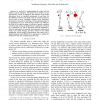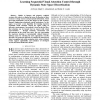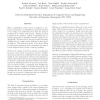471 search results - page 54 / 95 » Perceptual Grounding in Robots |
AIPS
1996
14 years 11 months ago
1996
Effective task-level control is critical for robots that are to engage in purposeful activity in realworld environments. This paper describes PRSLite, a task-level controller grou...
131
click to vote
ICRA
2010
IEEE
14 years 8 months ago
2010
IEEE
— A method for implementing the ankle and hip balance control strategies, well known from studies on human balance control, is suggested. The moment of the acting disturbance for...
ICRA
2009
IEEE
15 years 4 months ago
2009
IEEE
² Similar to humans and primates, artificial creatures like robots are limited in terms of allocation of their resources to huge sensory and perceptual information. Serial process...
ICRA
2002
IEEE
15 years 2 months ago
2002
IEEE
When a distributed robotic system is assigned to perform reconnaissance or surveillance, restrictions inherent to the design of an individual robot limit the system’s performanc...
AROBOTS
2008
14 years 10 months ago
2008
Online trajectory generation for robots with multiple degrees of freedom is still a difficult and unsolved problem, in particular for non-steady state locomotion, that is, when th...



